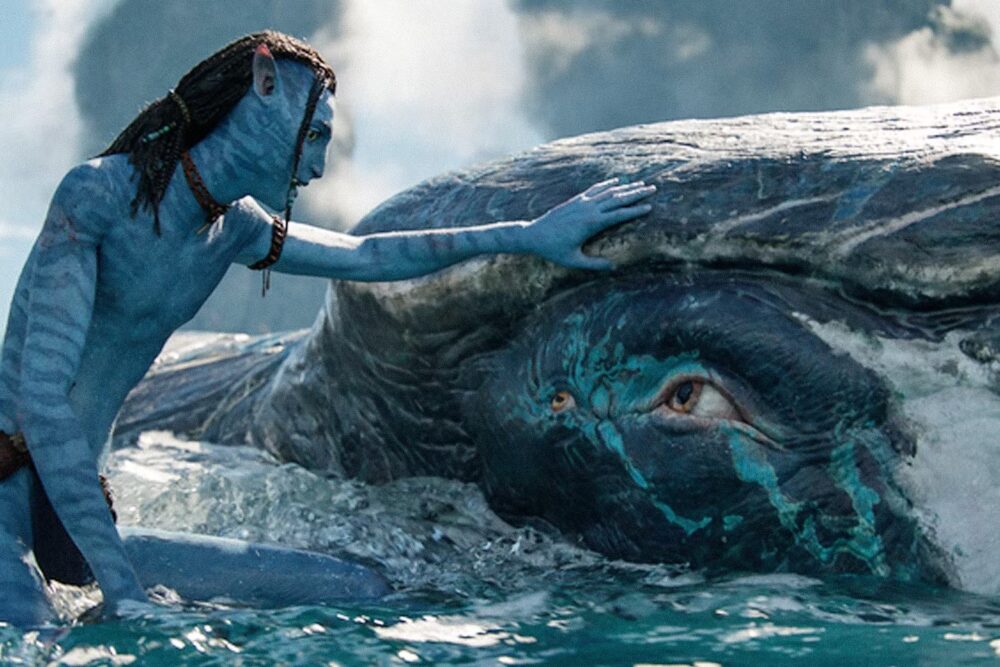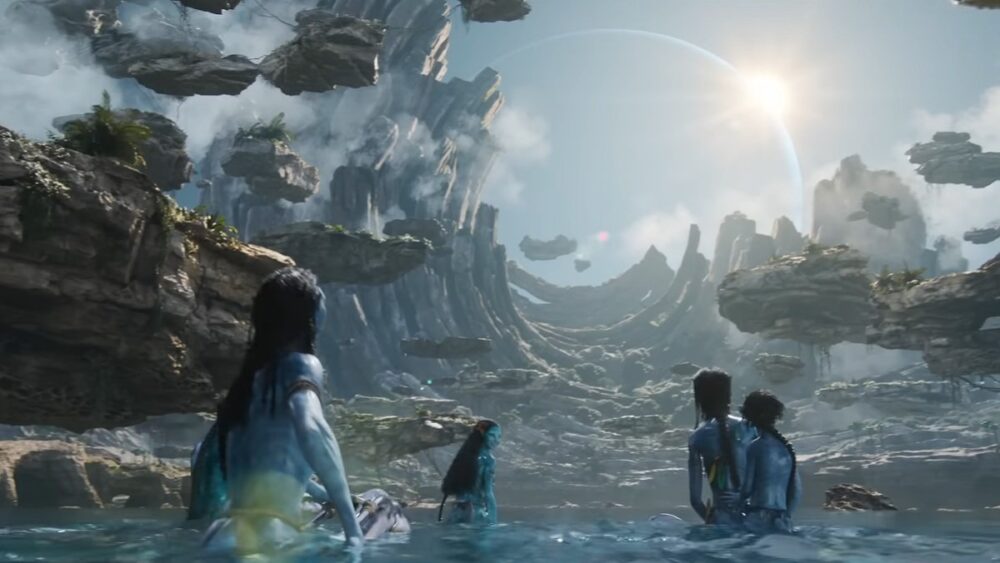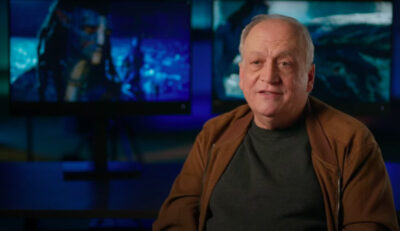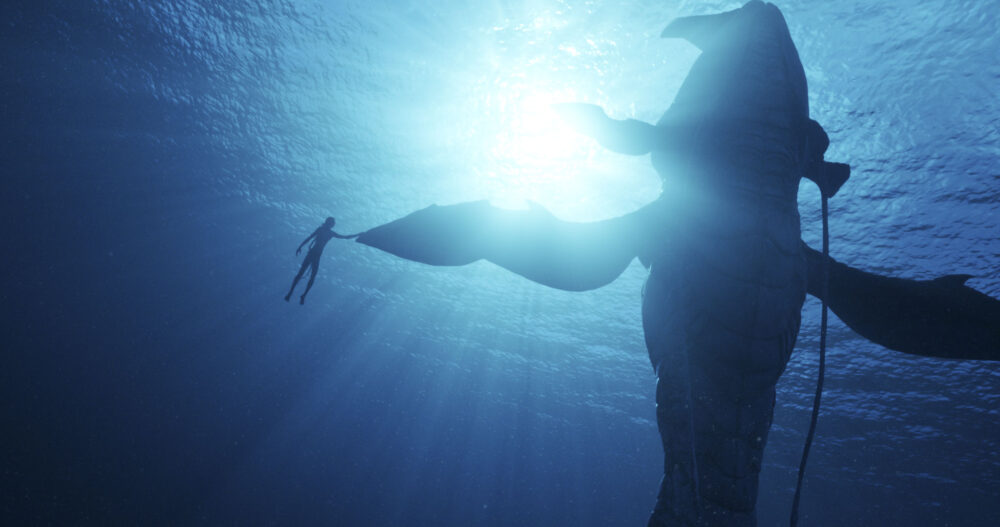***This article originally appeared in the February ’23 issue of Animation Magazine (No. 327)***
Watching the Hollywood blockbusters of James Cameron, it is not hard to point out the influence of his deep fascination with marine life, whether it be an underwater alien encounter in The Abyss, setting a love story aboard a doomed ocean liner in Titanic or depicting a coastal clan in Avatar: The Way of the Water, the first of four proposed sequels that takes place on the exomoon named Pandora.
Cameron and his VFX team discussed his eagerly anticipated feature, its state- of-the-art visual effects and their inspirations during a recent interview with Animation Magazine. “I would say that the first Avatar borrowed from the colors and patterns and the variety and the shape language, like the Wood Sprites being jellyfish-like, from shallow water marine life,” he explains. “All we were doing was taking the amazing aliens that exist right here on planet Earth and taking them out of context, changing their scale because some of them are quite tiny. The interesting truth of it is, we can’t beat nature’s imagination.”

Inspired by Natural Wonders
He adds, “But when tasked to tell a story, we have to come up with something interesting. The [film’s] ilu, for example, has the neck of a Plesiosaurus and the body of a manta ray that was turned into a biplane, so it has lower and upper wings. It’s a beautiful creature and looks completely plausible. It’s based on touchstones in reality, but is its own thing.”
The director acknowledges the evolution of VFX technology and its important role in the filmmaking process. “Anybody from my generation was going to go out and do our physical production,” notes Cameron. “Then we’re going to shoot plates for some small subset of the movie and those are going to be spectacular sequences that would be finished later during a long post production. However, for me, visual effects are the fabric of my craft as a filmmaker. There are days when I’m just hand-holding the camera and running around with the actors.”
He adds, “We’re just doing it within a space that allows the camera to be tracked so that we can set extend using CG. That’s the only difference from a straight live-action movie, but I get to do all of the stuff I used to love back in the day. The point is that my attitude towards visual effects is that it’s the heart and soul of how we create this other world and these otherworldly characters.”

Overseeing the digital animation and augmentation were production VFX supervisor Richard Baneham and the team at Wētā FX led by Joe Letteri and Eric Saindon with additional support provided by ILM. “We basically gave Wētā FX a big traunch of money to develop how to do water,” explains Cameron. “Everything from how water drains out of hair, how water sheds off of skin, how a person emerges from water, how their costume would take the weight of the water and then drain out, and how the water itself would react as it’s displaced around the body. They were working on that piece of the puzzle and we were working on the physical aspects of how to capture [everything] in water, which proved to be quite a daunting thing.”
Performance capture had to take place within three different situations and stitched together in real time. “They were in an infrared volume above the water, when they went into the water and were swimming on the surface or diving down, and they would go into an ultraviolet volume underwater,” he points out.

Selected performance capture moments were assembled together to produce what is referred to as a template. “We have a lab in Los Angeles consisting of 160 people who build these files that are a slightly cruder representation of the movie, but they describe exactly what it is we want to achieve,” states Richard Baneham. “There is a huge investment of time and energy in making that happen. The technology that we’re using onstage is part of the Wētā FX pipeline, so we are truly integrated with them from the inception of the shots all the way through to final execution. Jim [Cameron] is able to take the cameras that he or I did on set and literally repeat them on set with the live-action crew.”
Baneham adds, “We’re making a movie about an alien world, so we try to ground ourselves in a film language that is familiar. Jim would literally go, ‘What piece of equipment are we using to do that?’ He’s always thinking of it from a practical standpoint.”
Simulcam was an indispensable tool throughout the production. “We knew that the plates and live action would fit together because it was all captured in the right depth and lighting,” says Eric Saindon, senior VFX supervisor at Wētā FX. “[Cinematographer] Russell Carpenter was able to light it in a way that we don’t have to manipulate these plates like you typically have to. The plates drop into the CG environment and you know that they’re going to work because you see it in rough format early on when you’re shooting it.”

Saindon points out that the depth compositing and Simulcam worked even with the water. “We were able to see where the other characters were going to be in the water and waves as we shot it,” he notes. “Because of this, we knew that there was enough space for them later on.”
One of the film’s many dramatic sequences involves a whale-like creature. “The tulkun hunt is a great action sequence, but is also terribly sad,” says Saindon. “All of it happens at sea and we never went out on the water for any of the shots! Because of the way we shot the boats and gimbals and have them move properly in the water it feels like it was shot out on the water, and all we’re adding is a few things in the background.”

For senior VFX supervisor Joe Letteri, one of the most important aspects of the visuals were the advances made in facial animation. “There are two aspects to it,” he notes. “One is capturing the data, making sure that you understand what the actors are doing in the moment, and the second aspect involves translating that into unique characters that are based on the actors which have to hold their own on the screen. That’s where we have put the bulk of the effort, trying to get that realism not only in the technical visual sense but in the emotional sense. Basically, understanding what the actors are doing on the stage should translate to what the characters are doing on the screen.”
An important factor to consider is that the facial rig above ground does not hold up underwater. “The face is floating a little bit and you’ll tend to squint more underwater,” says four-time Oscar-winner Letteri, whose many credits include Avatar, King Kong and The Lord of the Rings and The Hobbit movies. “Things like that that may work for a human actor are not what you want these characters to be who spend their life in the water. I’m talking about the Metkayina characters which by design are more impervious to being in the water; their expressions are more natural underwater. We take that into account by mixing what the actors do above water with what we’re seeing them doing below water to craft that performance together.”

Better than Ocean Photography
Obviously, the Avatar sequels required years of planning and developing VFX technologies and methodologies. “We’re not going to make a movie just to do something new,” notes producer Jon Landau. “We’re going to do it because there is a new story that we want to tell and feel people will be compelled by. Now there are tools at our disposal from a technology standpoint that allow us to tell stories that we couldn’t tell in the past in a better, more compelling and engaging way.”
The creative and technological odyssey leading to Avatar: The Way of Water has been a highly rewarding experience for Cameron and his team. As the visionary director concludes, “The end result on the screen which is what I’m seeing every day as it is pouring in from Wētā FX is quite astonishing in terms of the veracity of the performances, the body movement, the hands, all of those things both in air and water. Of course, all of the water work is spectacular. It’s in the same league as ocean photography which was our original goal, but it’s not an easy one!”
Avatar: The Way of Water was released in theaters worldwide by 20th Century Studios in December. As of Jan. 1, the film had made $1.38 billion worldwide.













